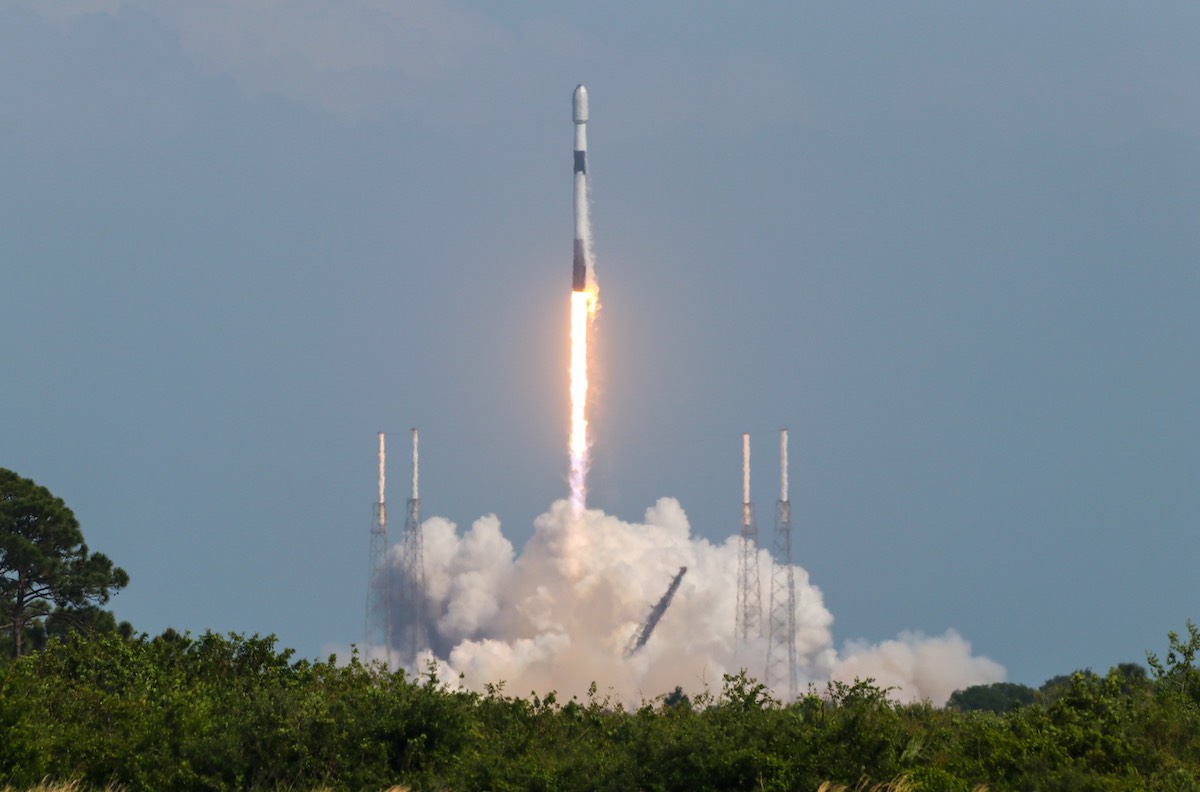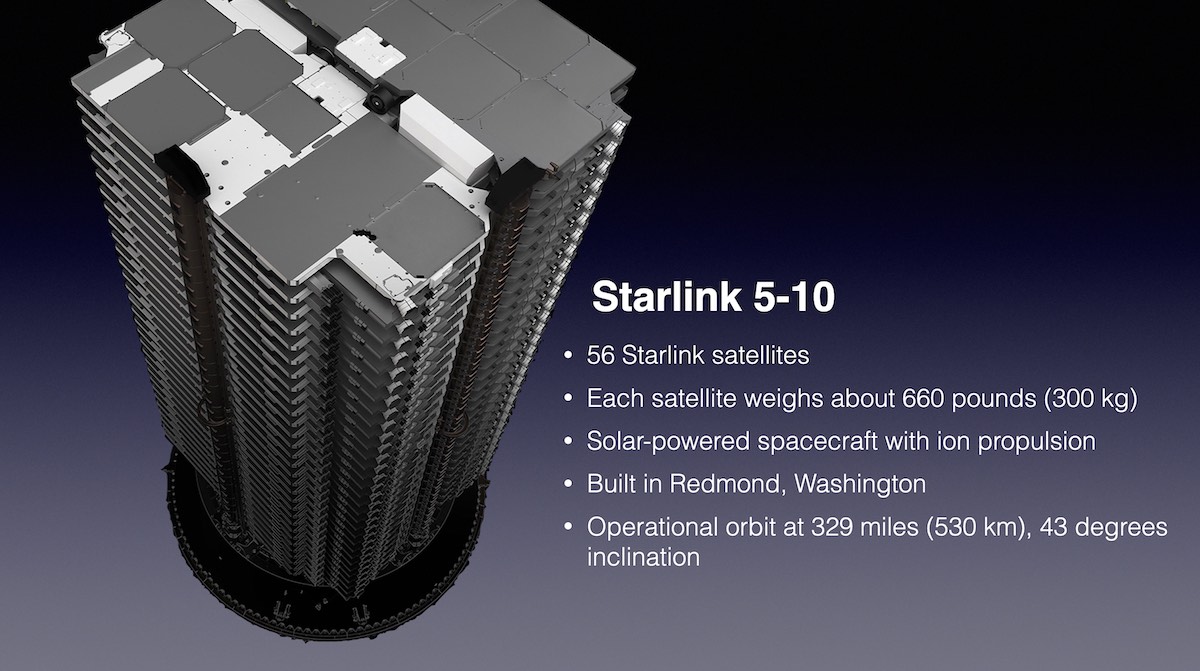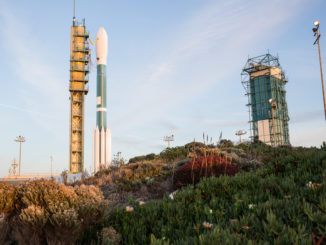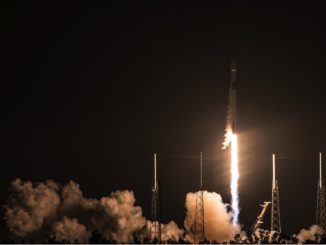Watch a replay of our live coverage of the countdown and launch of a SpaceX Falcon 9 rocket on the Starlink 5-10 mission at 4:01 p.m. EDT (2001 GMT) on March 29 from Space Launch Complex 40 at Cape Canaveral Space Force Station, Florida. Follow us on Twitter.
SFN Live
SpaceX delivered 56 more Starlink internet satellites into the company’s global internet constellation after liftoff of a Falcon 9 rocket from Cape Canaveral Wednesday, bringing the total number of Starlinks launched to 4,217 spacecraft.
The 229-foot-tall (70-meter) Falcon 9 rocket lifted off from pad 40 at Cape Canaveral Space Force Station at 4:01 p.m. EDT (2001 UTC).
The mission Wednesday, designated Starlink 5-10, continued deploying SpaceX’s older-generation Starlink V1.5 satellites after the company paused launches of new higher-capacity second-generation Starlinks this month.
Ground teams continue troubleshooting unspecified problems with the first batch of new Starlink V2 Mini satellites, which are larger and offer four times the broadband capacity of the older-design satellites. The first 21 Starlink V2 Mini satellites launched Feb. 27 on a Falcon 9 rocket, but stopped raising their altitude earlier this month.
Elon Musk, SpaceX’s founder and CEO, said the satellites encountered issues after the launch last month, and some of them could be deorbited while others could be salvaged to eventually move into the active Starlink fleet.
The new Starlink V2 Minis carry upgraded phase array antennas and a more efficient, higher-thrust argon-fueled electric propulsion system. They also have two solar arrays, compared to a single extendable solar panel on each Starlink V1.5 spacecraft.

SpaceX’s most recent mission last Friday launched 56 more older-generation Starlink V1.5 satellites, and the launch Wednesday followed a nearly identical profile to add 56 more.
While the Starlink V1.5 satellites are similar to the Starlink spacecraft SpaceX has launched over the last few years, SpaceX began launching Starlinks in December into orbital planes that are part of SpaceX’s second-generation, or Gen2, network. The Starlink 5-10 mission will continue the Gen2 deployments.
With the 56 new satellites on Wednesday’s flight, SpaceX has launched 4,217 Starlink spacecraft since the first prototypes in 2018. That number includes test satellites no longer in service, and satellites that have already re-enter the atmosphere.
SpaceX currently has more than 3,800 functioning Starlink satellites in space, with roughly 3,300 operational and more than 400 moving into their operational orbits, according to a tabulation by Jonathan McDowell, an expert tracker of spaceflight activity and an astronomer at the Harvard-Smithsonian Center for Astrophysics.
The Starlink V2 Mini satellites that SpaceX began launching in February represent an intermediate step between the smaller Starlink V1.5 spacecraft and the even larger full-size Starlink V2s, which SpaceX plans to deploy in orbit using the company’s new Starship mega-rocket.
The Starlink V2s will be capable of transmitting signals directly to cell phones. But with the Starship rocket still undergoing preparations for its first orbital test flight, SpaceX began launching the Gen2 satellites on Falcon 9 rockets and developed the V2 Minis to fit on the company’s existing launch vehicles.
The Starship has nearly 10 times the payload lift capability of a Falcon 9 rocket, with greater volume for satellites, too.
Liftoff of SpaceX’s Falcon 9 rocket on the Starlink 5-10 mission, boosting another 56 Starlink internet satellites into orbit from Cape Canaveral. https://t.co/dTPxqAedsk pic.twitter.com/0zjwPkzjZr
— Spaceflight Now (@SpaceflightNow) March 29, 2023
The Federal Communications granted SpaceX approval Dec. 1 to launch up to 7,500 of its planned 29,988-spacecraft Starlink Gen2 constellation, which will spread out into slightly different orbits than the original Starlink fleet. The regulatory agency deferred a decision on the remaining satellites SpaceX proposed for Gen2.
With the launch Wednesday, SpaceX has flown 330 Starlink Gen2 satellites into orbit.
Specifically, the FCC granted SpaceX authority to launch the initial block of 7,500 Starlink Gen2 satellites into orbits at 525, 530, and 535 kilometers, with inclinations of 53, 43, and 33 degrees, respectively, using Ku-band and Ka-band frequencies.
The FCC previously authorized SpaceX to launch and operate roughly 4,400 first-generation Ka-band and Ku-band Starlink spacecraft that SpaceX has been launching since 2019.
The Gen2 satellites could improve Starlink coverage over lower latitude regions, and help alleviate pressure on the network from growing consumer uptake. SpaceX says the network has more than 1 million active subscribers, mostly households in areas where conventional fiber connectivity is unavailable, unreliable, or expensive.
The Starlink spacecraft beam broadband internet signals to consumers around the world, connectivity that is now available on all seven continents.
Jonathan Hofeller, SpaceX’s vice president of Starlink commercial sales, said earlier this month the company is producing about six satellites per day at a Starlink factory near Seattle.
Like the first three Starlink Gen2 launches, the satellites on the Starlink 5-10 mission Wednesday will eventually maneuver themselves into a 530-kilometer-high (329-mile) orbit at an inclination of 43 degrees to the equator.

The first-generation Starlink network architecture includes satellites flying a few hundred miles up, orbiting at inclinations of 97.6 degrees, 70 degrees, 53.2 degrees, and 53.0 degrees to the equator. Last year, most of SpaceX’s Starlink launches have released satellites into Shell 4, at an inclination of 53.2 degrees, after the company largely completed launches into the first 53-degree inclination shell in 2021.
During Wednesday’s countdown, SpaceX’s launch team was stationed inside a launch control center just south of Cape Canaveral Space Force Station to monitor key systems on the Falcon 9 rocket and at the launch pad. SpaceX began loading super-chilled, densified kerosene and liquid oxygen propellants into the Falcon 9 vehicle at T-minus 35 minutes.
Helium pressurant also flowed into the rocket in the last half-hour of the countdown. In the final seven minutes before liftoff, the Falcon 9’s Merlin main engines were thermally conditioned for flight through a procedure known as “chilldown.” The Falcon 9’s guidance and range safety systems were also configured for launch.
After liftoff, the Falcon 9 rocket vectored its 1.7 million pounds of thrust — produced by nine Merlin engines — to steer southeast over the Atlantic Ocean. The Falcon 9 rocket exceeded the speed of sound in about one minute, then shut down its nine main engines two-and-a-half minutes after liftoff. The booster stage separated from the Falcon 9’s upper stage, then fired pulses from cold gas control thrusters and extended titanium grid fins to help steer the vehicle back into the atmosphere.
Two braking burns slowed the rocket for landing on the drone ship “Just Read the Instructions” around 410 miles (660 kilometers) downrange approximately eight-and-a-half minutes after liftoff. The reusable booster, designated B1077 in SpaceX’s inventory, flew on its fourth trip to space Wednesday.
SpaceX’s first stage booster landed on a football field-size drone ship downrange from Cape Canaveral, completing this rocket’s fourth flight to space. The upper stage of the Falcon 9 rocket is in a parking orbit with 56 Starlink internet satellites. https://t.co/YWDILBll27 pic.twitter.com/l8CCyFPWmz
— Spaceflight Now (@SpaceflightNow) March 29, 2023
The Falcon 9’s reusable payload fairing jettisoned during the second stage burn. A recovery ship was also on station in the Atlantic to retrieve the two halves of the nose cone after they splashed down under parachutes.
Landing of the first stage on Wednesday’s mission occurred just as the Falcon 9’s second stage engine cut off to deliver the Starlink satellites into a preliminary parking orbit. Another upper stage burn 54 minutes into the mission reshaped the orbit ahead of payload separation.
Separation of the 56 Starlink spacecraft, built by SpaceX in Redmond, Washington, from the Falcon 9 rocket was confirmed nearly 65 minutes after liftoff.
The Falcon 9’s guidance computer aimed to deploy the satellites into an orbit at an inclination of 43 degrees to the equator, with an altitude ranging between 185 miles and 210 miles (299-by-339 kilometers). After separating from the rocket, the 56 Starlink spacecraft will unfurl solar arrays and run through automated activation steps, then use their krypton-fueled ion engines to maneuver into their operational orbit.
ROCKET: Falcon 9 (B1077.4)
PAYLOAD: 56 Starlink satellites (Starlink 5-10)
LAUNCH SITE: SLC-40, Cape Canaveral Space Force Station, Florida
LAUNCH DATE: March 29, 2023
LAUNCH TIME: 4:01:00 p.m. EDT (2001:00 GMT)
WEATHER FORECAST: 60% chance of acceptable weather; Low-moderate risk of upper level winds; Low risk of unfavorable conditions for booster recovery
BOOSTER RECOVERY: “Just Read the Instructions” drone ship northeast of the Bahamas
LAUNCH AZIMUTH: Southeast
TARGET ORBIT: 185 miles by 210 miles (299 kilometers by 339 kilometers), 43.0 degrees inclination
LAUNCH TIMELINE:
- T+00:00: Liftoff
- T+01:12: Maximum aerodynamic pressure (Max-Q)
- T+02:28: First stage main engine cutoff (MECO)
- T+02:31: Stage separation
- T+02:38: Second stage engine ignition (SES 1)
- T+02:46: Fairing jettison
- T+06:12: First stage entry burn ignition (three engines)
- T+06:31: First stage entry burn cutoff
- T+08:04: First stage landing burn ignition (one engine)
- T+08:24: First stage landing
- T+08:37: Second stage engine cutoff (SECO 1)
- T+54:04: Second stage engine ignition (SES 2)
- T+54:06: Second stage engine cutoff (SECO 2)
- T+1:04:52: Starlink satellite separation
MISSION STATS:
- 214th of a Falcon 9 rocket since 2010
- 224th launch of Falcon rocket family since 2006
- 4th launch of Falcon 9 booster B1077
- 154th flight of a reused Falcon booster
- 183rd SpaceX launch from Florida’s Space Coast
- 119th Falcon 9 launch from pad 40
- 174th launch overall from pad 40
- 79th Falcon 9 launch primarily dedicated to Starlink network
- 19th Falcon 9 launch of 2023
- 20th launch by SpaceX in 2023
- 16th orbital launch attempt based out of Cape Canaveral in 2023
Email the author.
Follow Stephen Clark on Twitter: @StephenClark1.



